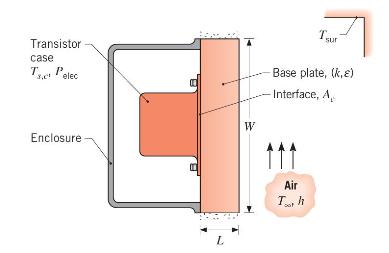Consider a power transistor encapsulated in an aluminum case that is attached at its base to a
Question:
Consider a power transistor encapsulated in an aluminum case that is attached at its base to a square aluminum plate of thermal conductivity \(k=240 \mathrm{~W} / \mathrm{m} \cdot \mathrm{K}\), thickness \(L=8 \mathrm{~mm}\), and width \(W=24 \mathrm{~mm}\). The case is joined to the plate by screws that maintain a contact pressure of 1 bar, and the back surface of the plate transfers heat by natural convection and radiation to ambient air and large surroundings at \(T_{\infty}=T_{\text {sur }}=30^{\circ} \mathrm{C}\). The surface has an emissivity of \(\varepsilon=0.9\), and the convection coefficient is \(h=8 \mathrm{~W} / \mathrm{m}^{2} \cdot \mathrm{K}\). The case is completely enclosed such that heat transfer may be assumed to occur exclusively through the base plate.

(a) If the air-filled aluminum-to-aluminum interface is characterized by an area of \(A_{c}=2 \times 10^{-4} \mathrm{~m}^{2}\) and a roughness of \(10 \mu \mathrm{m}\), what is the maximum allowable power dissipation if the surface temperature of the case, \(T_{s, c}\), is not to exceed \(85^{\circ} \mathrm{C}\) ?
(b) The convection coefficient may be increased by subjecting the plate surface to a forced flow of air. Explore the effect of varying the coefficient over the range \(4 \leq h \leq 200 \mathrm{~W} / \mathrm{m}^{2} \cdot \mathrm{K}\).
Step by Step Answer:

Fundamentals Of Heat And Mass Transfer
ISBN: 9781119220442
8th Edition
Authors: Theodore L. Bergman, Adrienne S. Lavine





